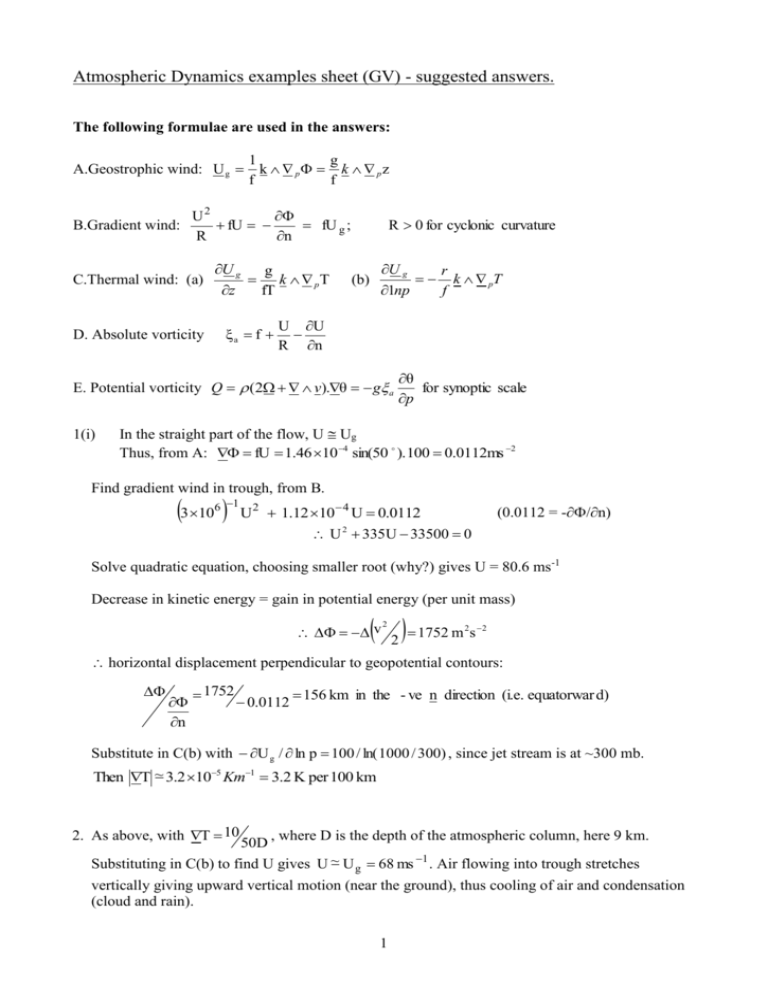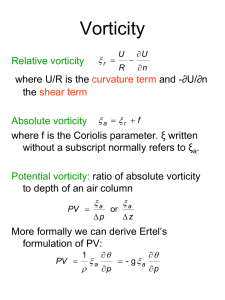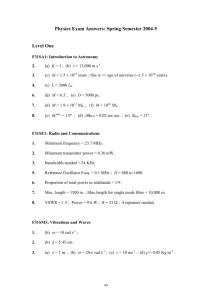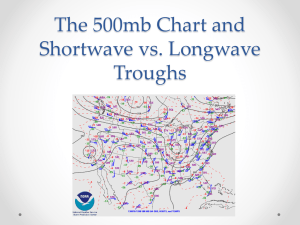Meteorology examples sheet - suggested answers
advertisement

Atmospheric Dynamics examples sheet (GV) - suggested answers. The following formulae are used in the answers: A.Geostrophic wind: U g B.Gradient wind: 1 g k p k p z f f U2 fU fU g ; R n C.Thermal wind: (a) D. Absolute vorticity U g g k pT z fT a f R 0 for cyclonic curvature (b) U g r k pT 1np f U U R n E. Potential vorticity Q (2 v).θ g a 1(i) θ for synoptic scale p In the straight part of the flow, U Ug Thus, from A: fU 1.46 10 4 sin(50 ). 100 0.0112ms 2 Find gradient wind in trough, from B. 310 6 1 U 2 1.12 10 4 U 0.0112 U 2 335U 33500 0 (0.0112 = -/n) Solve quadratic equation, choosing smaller root (why?) gives U = 80.6 ms-1 Decrease in kinetic energy = gain in potential energy (per unit mass) 2 1752 m s v 2 2 2 horizontal displacement perpendicular to geopotential contours: n 1752 0.0112 156 km in the - ve n direction (i.e. equatorwar d) Substitute in C(b) with U g / ln p 100 / ln( 1000 / 300) , since jet stream is at ~300 mb. Then T ~ 3.2 105 Km1 3.2 K per 100 km 2. As above, with T 10 , where D is the depth of the atmospheric column, here 9 km. 50D U g 68 ms 1 . Air flowing into trough stretches Substituting in C(b) to find U gives U ~ vertically giving upward vertical motion (near the ground), thus cooling of air and condensation (cloud and rain). 1 3. Amplitude of wave is 9 so if centre of wave is at 50N, ridge is at 54.5 and trough at 45.5. f at 45.5=1.04 10-4 s-1; at 50=1.12 .10-4s-1; at 54.5=1.19 10-4s-1 a) From A, using z 120 , U g 17.9ms -1 600000 b) Gradient wind in trough, from B with 2 10 3 ms 2 : n 2 R U RfU 0 n Solving the quadratic equation gives U=16.1 ms-1 Gradient wind in ridge, from B: U 2 RfU R 0 n Solving the quadratic equation gives U=21.8ms-1 c) There is no shear vorticity in this case. So, from D: a in trough 1.24 10 -4 s 1 ; a in ridge 0.918 10 -4 s 1 4. Again use D, with no shear vorticity term. R=912 km, from the formulae given: +ve in trough and –ve in ridge. f in trough (47.75) = 1.0810-4 s-1 so a =1.40910-4 s-1 f in ridge (52.25) = 1.1510-4 s-1 so a =0.82110-4 s-1 Fractional change in depth of air column is calculated using E. In the straight part of the flow, a =f=1.1210-4 s-1. 1.409 1.26 Since a is conserved, p( trough ) p(straight ) 1.12 p p(ridge ) 0.821 0.73 . p(straight) 1.12 5. For geostrophic wind (A), U=15 ms-1. In the trough, gradient wind is the solution of B: U2 + fRU - fRUg= 0 U2 + 100U – 1500 = 0 U = 13.2 ms-1 In the ridge, similarly, U=18.4 ms-1 In the straight part of the flow Ua, the ageostrophic wind, is zero. In the trough it is –1.8 ms-1. So the divergence in Ua in the flow entering the trough is 1.8 , approximately. ( 4) The flow is convergent (HU < 0) so downward motion (stretching of air columns) is forced at the tropopause. This persists throughout the troposphere. Downstream of the trough, HU is similar in magnitude but opposite in sign, so the flow is divergent near the tropopause and upward motion in the troposphere results. The same result can be derived directly from E: a increases from 10-4 s-1 (f) in the straight part of the flow to ~ 1.365 10-4 s-1 in the trough (from D and using gradient wind for U with same value of f). Conservation of PV demands that air columns stretch as a increases, so forcing downward motion. The opposite situation applies (obviously) downstream of the trough. 2






